
Drying the weekly wash before tumble dryers
In the past, every item in the wet wash/laundry had to be wound through the mangle to remove the majority of the water, but this still left it damp. How it was then dried depended on the weather because there were no spin driers or tumble driers. This page describes, explains and illustrates how drying the wash was done outdoors in good weather and indoors in bad weather.
____
Extracted from the memoirs of the webmaster's mother(1906-2002) and edited by the webmaster with further research and firsthand contributions from others
Drying the wash outdoors or indoors? The decision
The rule of thumb for drying and airing the wash/laundry seemed to be that if the pavements were dry and if there were no heavy clouds in the sky, out went the damp washing to dry in the fresh air. This was so in freezing weather too. Otherwise the wash had to be dried indoors which was much less straightforward.
How the wash used to be dried outside
The clothes line
Clothes lines were simply lengths of thin rope, slung between hooks or branches of trees. When not in use, most women wound them into a coils and stored them somewhere dry. If they were left out, they got dirty and the dirt transferred to the clean washing. On washday, they were got out and placed in position for drying the wash.
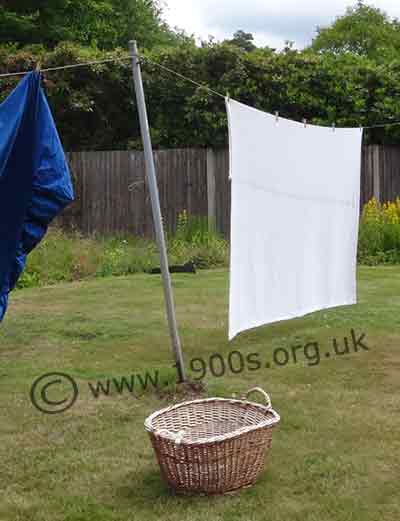
The clothes line and cane clothes basket*
The cane clothes basket
The clean, but wet washing was taken out into the garden in a basket, which of course was cane as there were no plastics. Then it was pegged onto the pepared clothes lines.
My mother and her next door neighbour would often find themselves in their gardens at the same time on Monday washday, and they would give one another cups of tea over the fence. I don't think there was time for much chatting.
Gypsy clothes pegs
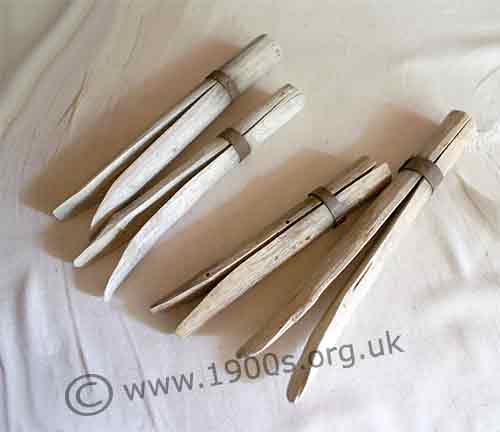
Clothes pegs, known as 'gypsy clothes pegs' or just 'gypsy pegs'**
The pegs were normally kept in a drawstring bag known as a peg back. They were what were known as 'gypsy clothes pegs' or just 'gypsy pegs' because gypsies made them and came round knocking at front doors selling them.
Each peg was made from a single piece of wood, split lengthways and held together with a nailed-on strip of tin can.
How the washing was pegged onto the washing line
Each item of the wash had to be pegged in such a way that the wind would blow through it to blow out the creases. This was to make Tuesday's ironing easier.
The collars of shirts would be stretched taut over the line and pegged where the collar met the rest of the shirt, (the other way up from what is shown in the photo) and pillowcases would be pegged at the open end, loosely and on one side only so that they would billow out as the wind blew through them. Sheets were folded double and pegged at each end, with one side pegged taut along its whole length and the other side sagging slightly, fold downwards.
The clothes prop
Once the clothes were pegged into position, the clothes line was propped up high in the air with a forked wooden prop to catch the wind.
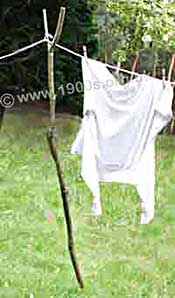
Clothes prop made from a sawn-off branch of a tree**
Specially made clothes props could be bought. Such a prop was a length of wood between nine and twelve feet long and about an inch and a half square with a slot in the top to hold the rope of the clothes line.
Some women, though, tended to use a suitably sawn-off forked trunk or branch of a small tree, as shown in the photo, but these could be dirty to handle. They were most common in rural areas.
Taking the washing down
When the washing was reasonably dry, it was taken down and brought in. Experience was necessary to choose the right point. The washing must never be bone dry because that made it difficult to iron the next day. On a sunny day, the washing dried quickly. The same was true on windy day, but wind had a another advantage in that some of the creases would blow out which did much of the ironing. The mangling helped too.
Since the fabrics were natural ones, almost everything needed to be ironed. So, in preparation for the ironing, every item of the wash was neatly folded, never left in a pile. If the wind had blown the sheets or tablecloths out of shape, I had to hold them while my mother tugged them back. With her greater strength, she would often pull them out of my hands. This made her very cross, and she would say, "Haven't you got any gumption?" I only learnt much later that gumption meant energy and commitment. Yes, I did have gumption, but I was a few stones lighter than she was.
The folded whites were rolled up while they were slightly damp, ready for ironing the next day, and if they were too dry my mother would sprinkle them with water first. This was called 'damping down'.
Tidying up
The pegs were taken off the line and stored in the peg bag, the line was coiled and hung up in the yard and the clothes prop was lent against the house.
How the wash used to be dried indoors in bad weather
Even in uncertain weather my mother would always try to put the washing outside to dry if at all possible. Sometimes frost hung on all day, and the washing would come in stiff like boards. Her fingers would be white with cold. This was called hot ache and could be very painful.
When the rain, frost or snow came, the wet clothes had to be put in the kitchen to dry. There were a number of ways to do this.
The fireguard
It was common practice to hang what we could over the fireguard of the kitchen range.
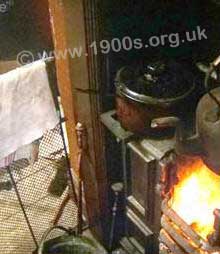
Damp clothes hanging over a fireguard to dry from the heat of the fire or the kitchen range***
This fireguard was made of strong wire mesh with a half inch strip of metal round the top, and it could be secured to the wall. It well-and-truly guarded against fire. I never think that today's ones are adequate, but I suppose they are not supposed to be functional as few people have open fires.
The trouble with drying clothes over the fireguard was that, large as it was, its space was very limited.
The clothes horse/airer
A particularly common method of drying indoors was to hang the washing over what was known as a clothes horse. One is shown in the photo. Presumably the name came from regular horses being used to carry things; today they are generally known as airers and are made of plastic covered metal. Old clothes horses were of course made of wood.
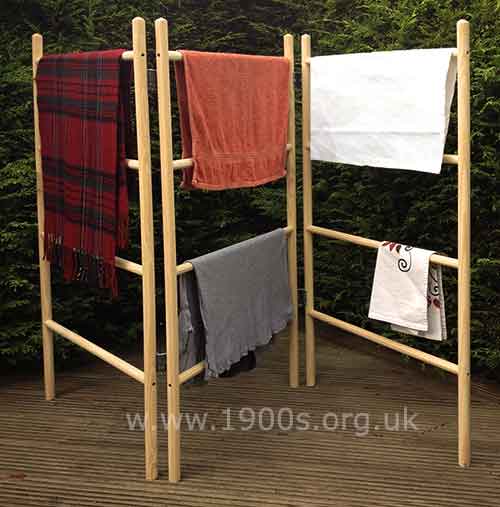
Wooden clothes horse**
Commonly clothes horses consisted of only two upright panels, but some had more, as shown in the picture because a panel couldn't hold much at a time.
Clothes lines strung across the kitchen
Clothes lines could be strung across the kitchen. They worked well but were depressing because they were so untidy and we had to keep dodging round them.
The ceiling airer
The most useful contraption for drying and airing clothes indoors consisted of rigid horizontal wooden bars over which the wash could be draped and which could be hauled up near the ceiling. It could hold a good number of items and was out of the way. For this reason it was called a ceiling airer. It is shown in the sketch.
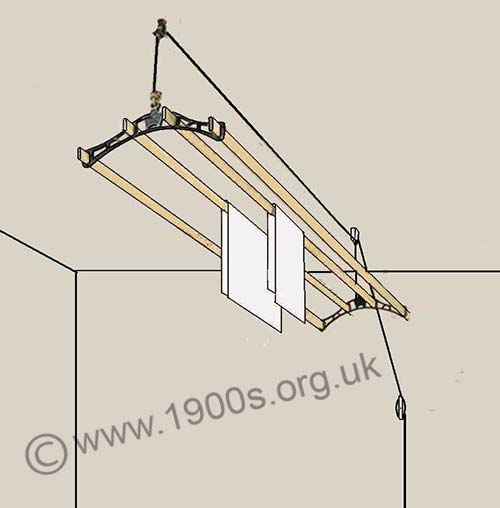
Sketch showing the working parts a ceiling airer****
Interestingly, ceiling airers are not generally seen today, probably because ceilings tend to be lower so that the clothes would brush against people's heads.
Alternative names for the ceiling airer
Pulley' is a Scottish term for this item, creel in Northern England and Sheila Maid in USA.
Douglas Adam
If you can add anything to this page or provide a photo, I would be pleased if you would contact me.
Text and images are copyright
*Photographed
by the webmaster on private premises
**Photographed by the webmaster at Tilford Rural Life
Centre
***Photographed by the webmaster in Milton Keynes Museum
****Drawn by Desmond Dyer for this website
sources: early 20th century material
sources: ww2 home front and other material
contact
the webmaster/author/researcher/editor
privacy policy
















